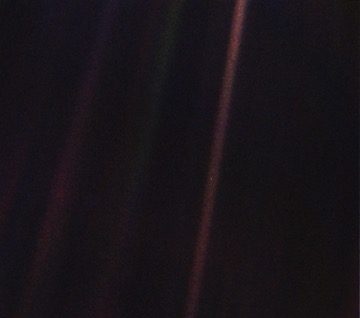
Exoplanets
Hi, I’m Rachel, the Astronomer here at the Space Centre.
Imagine for a moment that you are an alien adventurer who has ventured far from home to explore our solar system (though you, an extraterrestrial, would call it an exosystem). You were sent by your species on a mission to investigate the worlds of this system – to find out if these environments are suitable for life, and if they host intelligent lifeforms. You, being an alien, a foreigner, want to avoid accidentally contaminating our planets, so you’ve been given strict instructions not to land. Instead, you may only observe them from afar and make whatever inferences you can.
Your spacecraft stumbles upon our pale blue dot – humans call it Earth, but you, having just discovered this planet, have no name for it yet.

All you know is that it is an exoplanet, because it exists outside of your home planetary system. Squinting, you make out splashes of white from clouds and polar caps, swaths of brownish-greens, and some blue stuff that covers two-thirds of the surface. You take out a spectrometer – a device that identifies the chemical fingerprint of elements – and find carbon dioxide, ozone, and water vapour, amongst other atmospheric constituents. Next, you take out a humble telescope, giving you a resolution down to the scale of kilometers, and you can now make out rough landforms, an active atmosphere, an absence of ancient impact craters, and other signs that the planet is geologically active.
Would you be able to report back to your alien superiors, with absolute certainty, that intelligent lifeforms existed on this planet?
… probably not, at least not to the confidence level that science demands.
Astronomers on Earth face a similar problem, except we can’t travel to the exoplanet or exosystem to conduct our research – they’re all too far away. The closest exoplanet found thus far is Proxima Centauri b, at 4.24 light years away. Even if I strapped myself to the front of the fastest travelling spacecraft we have, the Parker Solar Probe (with a maximum speed of roughly 200 km/s), it would still take me over 6000 years to get there – much, much longer than the human lifespan.
So, how do astronomers find and characterize exoplanets that exist beyond our reach?
Finding exoplanets with signatures of life is partly having the right equipment and clever techniques, but also requires a bit of luck. We use light from these exosystems to research them; two detection methods dominate the search. One is the radial velocity (‘wobble’) method (or Doppler spectroscopy), in which the equal and opposite gravitational force exerted by orbiting planets on their host star causes the star to wobble, changing the colour of light (via the Doppler effect) we observe. Thus, a star’s wobble can tell us if an exostar has exoplanets, how many there are, and their size. The other is the transit method, in which we record how much a star’s light dims when a planet passes (transits) the star in our line of sight and its periodicity.
Detecting evidence of life, intelligent or not, requires a different flavour of analysis. As light propagates through an exoplanet atmosphere, some wavelengths of light will be absorbed by chemicals and gases in the atmosphere (each gas absorbs light in a specific wavelength/colour). This leaves behind black gaps in the spectrum we detect, almost like a barcode. By scanning the atmospheric barcode of each exoplanet, we can determine whether it has the ingredients for life. Finding a barcode with indicators of methane and oxygen would be promising, but we also can’t rule out life that subsists on a different kind of biochemistry. (To learn more about light visit our earlier post – light)
So where are we in terms of answering the age-old question: “are we alone?” As of today (August 25, 2020), NASA has confirmed 4201 exoplanets and has 5481 awaiting confirmation; although, none of these bear the hallmarks of life. Despite this, I, an optimist, am still compelled to believe that extraterrestrial life probably exists out there. Given the almost incomprehensible size and age of the universe, it feels almost arrogant to assert that we are the only form of intelligence in an ever-expanding spacetime. It’s only a matter of time.
Junior Astronomer Playlist (kids 8-12)
Time
Activity
5 mins
Discover more about how exoplanets are detected and the different kinds of exoplanets out there.
Ask yourself: What are you curious to learn more about exoplanets?
5 mins
Find out what a barycenter is and how it helps scientists find exoplanets.
Ask yourself: What does a star look like it’s doing when it has a planet orbiting it?
30 mins
Search the Milky Way, our home galaxy, in search of strange worlds beyond Earth using NASA’s Eyes on Exoplanets interactive application. Once you complete all 9 quests, you can print out a certificate or some cool posters to hang up in your room here on Earth.
Ask yourself: Is there an exoplanet that you would like to visit?
5 mins
120+ mins
Join the search for undiscovered worlds with the citizen science project Planet Hunters TESS.
Ask yourself: How did you feel about doing the data analysis?
Senior Astronomer Playlist (teens 13-15/adults)
Time
Activity
30 mins
Gaze up at an alien sky with NASA’s Exoplanet Travel Bureau, or print out some posters to hang up in your room here on Earth. For even more information and visualizations of these alien worlds, check out NASA’s Eyes on Exoplanets interactive application.
Ask yourself: Which exoplanet fascinates you the most?
10 mins
Find out what goes into naming an exoplanet and get to know the new Cree names Canadians gave to a star and its exoplanet in the constellation Bootes
Ask yourself: What would you name an exoplanet, if you discovered one?
30 mins
Discover more about how Hubble and the James Webb Space Telescope will study the atmospheres of exoplanets using spectroscopy.
Build your own paper model of the Hubble or Webb telescope here.
Ask yourself: What do you think are the advantages and disadvantages of space telescopes?
30 mins
Explore the technology scientists use to shield a telescope’s camera from the light of a distant star by building your own origami Starshade. Dig deeper into the relationship between origami and science by watching this video about a former NASA scientist who has become a legend in the origami world.
Ask yourself: Can you think of any other surprising intersections between science and art?
120+ mins
Check out some of the major discoveries made by NASA’s Transiting Exoplanet Survey Satellite (TESS) during its primary mission.
Join the search for undiscovered worlds by helping scientists analyze TESS data with the citizen science project Planet Hunters.
Ask yourself: What role do you think citizen science plays in research and scientific progress?

